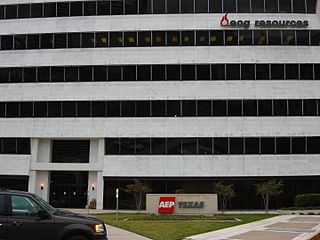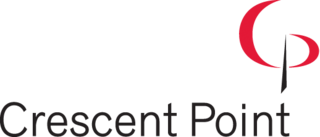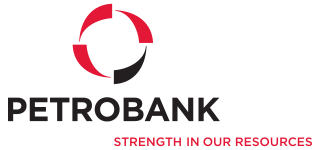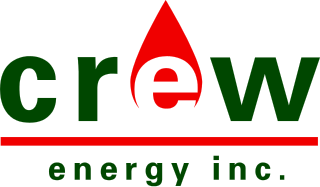
Oil sands, tar sands, crude bitumen, or bituminous sands, are a type of unconventional petroleum deposit. Oil sands are either loose sands or partially consolidated sandstone containing a naturally occurring mixture of sand, clay, and water, soaked with bitumen, a dense and extremely viscous form of petroleum.

Husky Energy Inc. was a Canadian company engaged in hydrocarbon exploration, headquartered in Calgary, Alberta, Canada. It operated in Western and Atlantic Canada, the United States and the Asia Pacific region, with upstream and downstream business segments. In the 2020 Forbes Global 2000, Husky Energy was ranked as the 1443rd-largest public company in the world.

Ovintiv Inc. is an American petroleum company based in Denver. The company was formed in 2020 through a restructuring of its Canadian predecessor, Encana.

Petroleum production in Canada is a major industry which is important to the overall economy of North America. Canada has the third largest oil reserves in the world and is the world's fourth largest oil producer and fourth largest oil exporter. In 2019 it produced an average of 750,000 cubic metres per day (4.7 Mbbl/d) of crude oil and equivalent. Of that amount, 64% was upgraded from unconventional oil sands, and the remainder light crude oil, heavy crude oil and natural-gas condensate. Most of the Canadian petroleum production is exported, approximately 600,000 cubic metres per day (3.8 Mbbl/d) in 2019, with 98% of the exports going to the United States. Canada is by far the largest single source of oil imports to the United States, providing 43% of US crude oil imports in 2015.

EOG Resources, Inc. is an American energy company engaged in hydrocarbon exploration. It is organized in Delaware and headquartered in the Heritage Plaza building in Houston, Texas.

Crescent Point Energy Corp. is an oil and gas company based in Calgary, Alberta, Canada. The company focuses primarily on light oil production in southern Saskatchewan and central Alberta. Since its inception in 2001, Crescent Point has significantly increased its production. The company was founded in 2001 and is one of the largest independent oil and gas producers in Canada and has a significant presence in the Western Canadian Sedimentary Basin. The company's operations also include assets in the Williston Basin in the United States. Crescent Point Energy is listed on the Toronto Stock Exchange and is a publicly traded company.

Obsidian Energy Ltd. is a mid-sized Canadian oil and natural gas production company based in Calgary, Alberta.
Enerplus Corporation is one of Canada’s largest independent oil and gas producers. The company holds oil and natural gas property interest in the United States and in western Canada, in the provinces of Alberta, British Columbia and Saskatchewan. The company is based out of Calgary, Alberta and traded on both the Toronto Stock Exchange and the New York Stock Exchange before being acquired by Chord Energy. It was Canada's first income trust.

The Cardium Formation is a stratigraphic unit of Late Cretaceous age in the Western Canada Sedimentary Basin. It takes the name from the fossilized heart-shaped cockle shells in the family Cardiidae present. It was first described along the Bow River banks by James Hector in 1895. It is present throughout western Alberta and in northeastern British Columbia, and it is a major source of petroleum and natural gas.

Although there are numerous oil companies operating in Canada, as of 2009, the majority of production, refining and marketing was done by fewer than 20 of them. According to the 2013 edition of Forbes Global 2000, canoils.com and any other list that emphasizes market capitalization and revenue when sizing up companies, as of March 31, 2014 these are the largest Canada-based oil and gas companies.
Cenovus Energy Inc. is a Canadian integrated oil and natural gas company headquartered in Calgary, Alberta. Its offices are located at Brookfield Place, having completed a move from the neighbouring Bow in 2019.
The Duvernay Formation is a stratigraphical unit of Frasnian age in the Western Canadian Sedimentary Basin.

Petrobank was an oil exploration, development, and production company based in Calgary, Canada. It operates through 4 units/subsidiaries, PetroBakken Energy in Canada, Petrominerales Ltd in Peru and Colombia, HBU in the heavy crude oil business, and its technology unit Archon Technologies Ltd . In 1986 the company changed its name from Petrobank Energy Resources Ltd. to Petrobank Energy and Resources Ltd. Though it has a significant resource base its ten patents for heavy oil extracting technology are becoming increasingly valuable to the company. In December 2010 the company received permission from the government of Alberta to produce oil sands bitumen at a new location in Dawson using a technique known as fireflooding, the third Petrobank operation that will use it; the 50% interest in Dawson was acquired in October from Shell Canada.

Questerre Energy Corporation (QEC) is an international energy exploration company headquartered in Calgary, Canada, and listed on the Toronto Stock Exchange and the Oslo Stock Exchange. It holds the largest acreage position in the Utica Shale in the Saint Lawrence Lowlands. Questerre also have operations in Saskatchewan and in the Montney Formation in Alberta.

Vermilion Energy is an international oil and gas producer based in Calgary, Canada. It has operations in North America, Europe and Australia. Vermilion is listed on the Toronto Stock Exchange and the New York Stock Exchange.

Crew Energy Inc. is a growth-oriented, liquids-rich natural gas producer, committed to pursuing sustainable per share growth through a balanced mix of financially responsible exploration and development complemented by strategic acquisitions. The Company’s operations are exclusively focused in the vast Montney resource, situated in northeast British Columbia, and include a large contiguous land base. Crew's liquids-rich natural gas areas of Septimus and West Septimus and Groundbirch in British Columbia offer significant development potential over the long-term. The Company has access to diversified markets with operated infrastructure and access to multiple pipeline egress options. Crew’s common shares are listed for trading on the Toronto Stock Exchange under the symbol “CR”.

Canadian Natural Resources Limited, or CNRL or Canadian Natural is a senior Canadian oil and natural gas company that operates primarily in the Western Canadian provinces of British Columbia, Alberta, Saskatchewan, and Manitoba, with offshore operations in the United Kingdom sector of the North Sea, and offshore Côte d'Ivoire and Gabon. The company, which is headquartered in Calgary, Alberta, has the largest undeveloped base in the Western Canadian Sedimentary Basin. It is the largest independent producer of natural gas in Western Canada and the largest producer of heavy crude oil in Canada.

Fracking in Canada was first used in Alberta in 1953 to extract hydrocarbons from the giant Pembina oil field, the biggest conventional oil field in Alberta, which would have produced very little oil without fracturing. Since then, over 170,000 oil and gas wells have been fractured in Western Canada. Fracking is a process that stimulates natural gas or oil in wellbores to flow more easily by subjecting hydrocarbon reservoirs to pressure through the injection of fluids or gas at depth causing the rock to fracture or to widen existing cracks.
Whitecap Resources is a Canadian public oil company based in Calgary, Alberta, with operations in Alberta, Saskatchewan, and British Columbia. In 2018, it produced 74,415 barrels of energy per day, with 85% of production consisting of crude oil and other liquids. It is listed on the Toronto Stock Exchange.
Tourmaline Oil is a Canadian energy company engaged in the exploration, development, and extraction of crude oil and natural gas. It is headquartered in Calgary, Alberta in Canada. A major natural gas producer, it became the largest natural gas producer in Canada in 2021. It is also the first Canadian oil and gas exploration and development company to directly engage in the liquified natural gas business.













